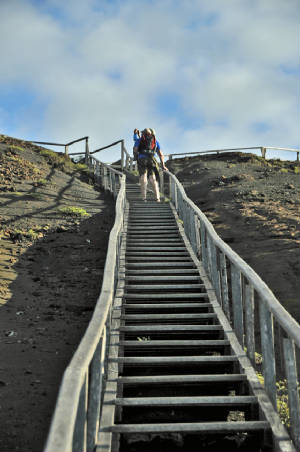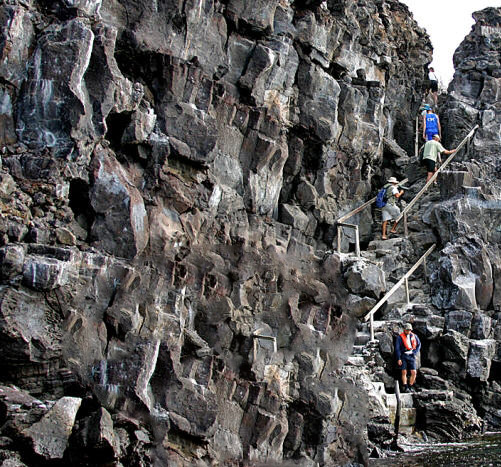|
transportation between the ship and the shore.
We didn't get soaked but did get our feet wet
could involve some physical dexterity. Wade out to the Zodiac,
sit on the gunwale and than swing your feet into the boat.
I wore swim trunks and a long sleeve Lycra shirt, no so
much to stay warm but to guard against sunburn and sea critters that can sting.
then when it went
out, this little waterfall was created. Repeat
Came across this three master when we were returning to the airport

and knew almost everything there was to know about the Galapagos.
Turns out that one was originally from Texas. A little town near Fort Stockton, Ozona.
The guy in the orange T-shirt was the Ship's Doctor. Yup, a real MD
The red haired guy with glasses was the videographer. He made the video that is attached to this site.
The one with the beard next to him was the Tour Director.
We had a lifeboat drill immediately upon embarkation and a refresher mid-way through the expedition.
We had to have life jackets on before embarking on a Zodiac and immediately after reembarking from an island.

found no where else on the Earth.
I have seen a similar one in the Hawaiian Islands.
I am certain that there are many more but they are interesting to watch.
I think the boat captains had been doing it long enough that they knew exactly
what speed to run to give us the best ride. Good idea as they were the ones
that had to clean up their boats! I do not remember a single person sea-sick
on the trip. Only one casualty that I know of. Someone wearing flip-flops while
hiking the lava beds, slipped and took the hide of a heal. Nasty 3" gash.
of the volcano that forms the island. We will be hiking from sea level up to 359'.
That doesn't sound like much but it is the height of a 30 story office building with no elevators, and is is very warm.
The ground consists of very fragile volcanic stone. A footprint breaks the surface crust and exposes the ground to severe erosion.
The Park Service has constructed wood walkways and stairs to the top. We are prohibited from leaving these walkways.
Note: What you see here is lava so we could walk on it.
Starting up the walkway from the landing area.

Heading up

Getting there
You can see the fragile volcanic soil here that was mentioned earlier.
Here is the view from the top. Definitely worth it!
Galapagos landmarks
collapsed small caldera. (volcano)
is a picture to prove it!
lava. The outside of the stream cools while the interior stays hot.
The interior molten lava then drains out the bottom end of the tube,
leaving a pipe-like structure, which here has collapsed into itself.
We were treated to some spectacular sunsets.

I don't believe I ever felt a
rain drop during the whole trip.

Phillip's Steps, named after his visit here in 1974
 |
| File |
This massive basalt cliff was like looking straight up from
the Zodiac.
It was several hundred feet high.
narrow opening while going down a very steep trail to get
to the top of the steps. The blue pack is the person just below.
Crews of whaling ships on their outward journey would drop letters in the barrel. Crews on their
way back to the East Coast or Europe would pick up these letters and deliver them to the crew's
families. Now, expedition ships have post cards on board. If you wish, you address a card to
yourself and drop it in the barrel. Each expedition leader that arrives at the barrel goes through
the cards and calls out the city and state it is addressed to. If you live there, you can take the
card, but you must promise to deliver ti in person.
someone may knock on my door with it, having
picked up at Post Office Bay and promising to
deliver it to me. The closest one when I was there
was in Austin, but the address was a high-rise
office building downtown. Was not about to sign up
to deliver that one.
Wish I had a dollar for every time this view has been photographed.
The sheer basalt cliff was on the other side of this small island. We
did not visit the one in the distance.
These are Red Mangroves. Not much to look at but essential to the marine population of the Galapagos.
The is the nursery of most marine fish found here. No mangroves, no fish!
by a donkey but as they have been removed from the
islands, it is now man powered for the demonstration.
Cain stocks are fed into the press on the side where
the man is standing. You can see pieces laying on the
ground next to him
and pressed allowing the high sugar content juice to run
out.
Originally, wood buckets were used but I guess technology
catches up with everything; hence the red plastic
bucket.
Sort of ruined the ambiance though.
It can be further dried into brown cane sugar. 80 gallons of juice will produce
9-12 gallons of molasses. OR:
And, yes he is making rum! 100 gallons of juice
will produce 12 - 3 gallons of rum. Alcohol is
produced by the fermentation of sugar. When the
alcoholic content reaches 12 - 13 percent, the
alcohol is strong enough to kill off the microbes in
the fermentation process so no more alcohol is produced.
Is proof and percent the same? No, Proof is double the percent alcohol
contained in the beverage. So 80 proof is 40% alcohol. How do we get
from 12 % to 40%?
has a lower boiling point than water, so if we heat the fluid
slowly, the first traces of steam will be pure alcohol.
There is a lot of technical stuff involved as well.This is why,
wine, which is not distilled comes in at around 12%
180 proof, (90%) is about the limit. Pure alcohol has no taste or color. Its the 10% impurities that
provide each liquor's distinctive taste, odor and color (and hangover). These three photos were shot
at a speed of 6 shots per second so each represents 1/6th of a second. This is what happens when
about 1/2 cup of 180 proof alcohol is thrown into a fire.
Click on the link below
for The Blue Flame. I happened to "stumble" across this document
while working ine the Middle
East. Some of the ARAMCO Oil Expats had stills that
were works of art. Stainless steel, silver soldered.
Beautiful!
No, Micky, your name is spelled with an M first.
Oh, that's what you thought of it!
Well, maybe Bacardi has a secret formula
I don't think I want to give it a hug. It can grow to 12 feet.
No, actually it is a variety of Prickly Pear only found in the Galapagos.
No, it is a Prickly Pear but one only found on Santa Cruz Island.
It can grow to a heigth of 40 feet. its a: O echios var. gigantea
Again this species is only found in the Galapagos.
to the Galapagos and head for Quito
We flew in an a 373 stretch and out on an Airbus 320. (I hope I have to models right) The flight out we even had
in-seat entertainment. And both were spotless!
Note the Galapagos motif in the planes decor.
|
|